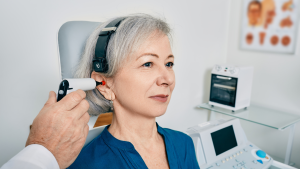Hearing loss affects more than 1.5 billion people worldwide, making it one of the most common chronic health conditions across all age groups. For older adults in particular, age-related hearing loss—or presbycusis—is a major contributor to social isolation, cognitive decline, and reduced quality of life. While technologies like hearing aids and cochlear implants have improved significantly, they still come with limitations. These devices amplify sound or bypass damaged areas of the ear, but they don’t restore natural hearing or repair the underlying damage.
Enter stem cell research—an exciting and rapidly advancing field that holds the potential to regenerate the delicate structures of the inner ear, offering not just a workaround for hearing loss, but possibly a cure. Scientists around the world are exploring how stem cells could be used to grow new hair cells and neurons in the cochlea, potentially reversing sensorineural hearing loss, the most common form of hearing impairment.
As breakthroughs continue in laboratories and early clinical trials begin to show promise, the question shifts from if stem cell therapy will help restore hearing to when it might become a viable treatment. In this article, we’ll explore what makes stem cell research so groundbreaking for hearing restoration, where the science currently stands, and what the future could look like for those living with hearing loss.
Understanding Hearing Loss and Its Challenges
To appreciate the revolutionary potential of stem cell therapies, it’s important to understand how hearing works—and what goes wrong when hearing loss occurs. The process of hearing begins when sound waves enter the ear canal, causing the eardrum to vibrate. These vibrations travel through the middle ear bones to the cochlea, a fluid-filled structure in the inner ear. Inside the cochlea are specialized sensory cells called hair cells, which convert these vibrations into electrical signals. These signals are then transmitted to the brain via the auditory nerve, allowing us to perceive sound.
The problem arises when these hair cells or auditory neurons become damaged or die. The most common type of permanent hearing loss—sensorineural hearing loss—typically results from the gradual loss of these cells due to aging, noise exposure, or ototoxic medications. Unlike some other tissues in the body, human inner ear structures do not regenerate on their own. Once hair cells are lost, the damage is irreversible with current medical treatments.
Traditional solutions like hearing aids amplify sound to help people hear better, but they don’t address the root cause. Cochlear implants can bypass damaged cells to stimulate the auditory nerve directly, offering more advanced assistance, particularly for severe hearing loss. Still, these are assistive technologies, not restorative ones. They require ongoing adjustment and maintenance, and outcomes vary widely depending on the individual’s level of damage and how long they’ve lived with hearing loss.
Moreover, many people experience difficulty hearing in noisy environments, detecting subtle sounds, or recognizing speech even with these devices. For those seeking to regain the natural experience of hearing, the current options fall short. This is where regenerative medicine—and specifically, stem cell research—offers a radical new direction. Instead of bypassing or amplifying, the goal is to replace and restore.
Understanding the biology of hearing and the permanence of inner ear damage is crucial to recognizing why stem cell therapies are such a hopeful prospect. The next section will dive into what stem cells are and how they might be used to bring hearing back in ways that were once thought impossible.
What Are Stem Cells and How Could They Help?
Stem cells are often described as the body’s raw materials—unspecialized cells with the unique ability to develop into many different types of cells. Unlike most cells in the body, which are locked into a specific role (like skin cells or muscle cells), stem cells can divide and transform into specialized cells, making them invaluable for regenerative medicine.
There are several types of stem cells relevant to hearing research:
- Embryonic stem cells, which can become any cell type in the body.
- Adult stem cells, found in various tissues like bone marrow or fat, with more limited potential.
- Induced pluripotent stem cells (iPSCs), which are adult cells genetically reprogrammed to behave like embryonic stem cells—an innovation that sidesteps many ethical concerns.
In the context of hearing restoration, researchers are particularly focused on using these cells to regenerate cochlear hair cells and auditory neurons, the primary culprits in sensorineural hearing loss. In many animals, including birds and fish, these cells can naturally regenerate after damage. Humans, however, lost this ability millions of years ago through evolution. The goal of stem cell therapy is to reintroduce this regenerative potential artificially.
The process typically involves harvesting or creating stem cells in a lab, then guiding them to become the specific type of cell needed—such as inner ear hair cells. Once developed, these cells could be implanted into the cochlea, ideally integrating into the existing auditory system and restoring function. In some experimental models, these stem-cell-derived hair cells have successfully responded to sound and even formed synaptic connections with neurons, which are critical for transmitting sound information to the brain.
Stem cells may also be used to protect existing cells from further damage. For example, some approaches involve delivering stem cell-derived support cells that secrete protective or anti-inflammatory factors into the inner ear, potentially slowing or halting the progression of hearing loss.
While the idea of regenerating inner ear structures sounds like science fiction, the groundwork is already being laid in research labs around the world. Scientists are learning how to reliably grow and control these cells, improving the chances that they could one day be used to treat real patients.
Current Progress in Stem Cell Research for Hearing Restoration
In just the past two decades, stem cell research in hearing restoration has evolved from a theoretical concept into a promising area of applied science. While no stem cell-based therapy for hearing loss has yet received FDA approval, preclinical studies and early-stage clinical trials are laying the groundwork for future breakthroughs.
One of the most significant advances came when researchers successfully converted stem cells into cochlear hair cells in the lab. In experiments using animals, particularly mice, these lab-grown cells were transplanted into damaged cochleae, where they showed signs of integration and functional response to sound. Although these are early findings, they demonstrate that it’s possible to regenerate hair-cell-like structures from stem cells.
Similarly, scientists have been working on generating auditory neurons from stem cells. This is crucial because even if hair cells are restored, they must connect to functional neurons to transmit sound signals to the brain. Encouragingly, lab-grown neurons have been shown to form synaptic connections with existing auditory pathways in test models, a key step toward full hearing restoration.
Institutions leading this research include:
- Harvard Medical School and Massachusetts Eye and Ear, where researchers have developed innovative techniques to stimulate supporting cells in the ear to become new hair cells.
- Stanford University, focusing on using induced pluripotent stem cells (iPSCs) to create personalized therapies for genetic hearing loss.
- The University of Sheffield (UK) and RIKEN Institute (Japan), where efforts are ongoing to deliver stem cells into the cochlea using precise, minimally invasive techniques.
Meanwhile, companies like Frequency Therapeutics have explored alternative regenerative approaches by activating the body’s own progenitor cells, although their clinical trials have faced setbacks. Others, like Audion Therapeutics, are developing small molecules that mimic some of the benefits of stem cells by promoting hair cell regeneration.
The first human clinical trials using stem-cell-derived therapies for hearing loss are already underway or in planning phases. These trials are closely watched for safety and efficacy, particularly to assess whether transplanted cells can survive, integrate, and function as intended in the challenging environment of the inner ear.
Still, much work remains. Ensuring that new cells don’t cause immune reactions, overgrow into tumors, or fail to connect properly are major concerns. But progress is accelerating, and each successful study brings researchers closer to making stem cell therapy a clinical reality.
Challenges and Ethical Considerations
While the promise of stem cell therapy for hearing restoration is compelling, several significant hurdles remain before these treatments can become widely available or approved for clinical use. These challenges are scientific, technical, regulatory, and ethical in nature—and each must be addressed carefully to ensure safe and effective therapies for patients.
Scientific and Technical Barriers
One of the biggest obstacles lies in cell delivery and integration. The cochlea is a small, spiral-shaped organ encased in bone, making it difficult to access without causing damage. Accurately delivering stem cells to the right location—and ensuring they stay there—is a delicate task. Even when placed correctly, these cells must survive, differentiate, and form proper connections with existing neural pathways. So far, much of this has only been achieved in controlled laboratory settings, and scaling up to human anatomy presents new layers of complexity.
Another concern is cell control. Scientists need to ensure that the transplanted cells behave as expected and don’t lead to unintended consequences. A key fear is the potential for tumor formation (teratomas), which can occur if even a few undifferentiated stem cells begin to divide uncontrollably. Researchers must also confirm that new hair cells and neurons function like their natural counterparts—responding to sound, transmitting signals, and adapting to a wide range of auditory environments.
Regulatory and Safety Hurdles
Before any stem cell therapy can reach the public, it must pass through rigorous clinical trials that assess not only effectiveness but also long-term safety. This process can take many years and involves multiple trial phases, regulatory approvals, and significant investment. So far, the studies in humans have been small and preliminary, focusing primarily on safety.
Moreover, different countries have different regulatory frameworks, which can either accelerate or slow down development. In the U.S., for instance, the FDA requires stem cell therapies to undergo a detailed approval process, while other countries may have less stringent oversight, leading to the rise of so-called “stem cell tourism,” where patients travel abroad for unproven and often unsafe treatments.
Ethical Issues
Ethical concerns also play a role, particularly around the use of embryonic stem cells, which are harvested from early-stage embryos. While these cells are powerful and versatile, their use has sparked debates about the moral status of embryos. As a result, many researchers now focus on induced pluripotent stem cells (iPSCs), which offer similar capabilities without the ethical baggage.
Another ethical issue involves access and equity. If and when stem cell therapies become available, they may be expensive and limited to those who can afford them. This raises questions about who gets access to cutting-edge treatments and how to ensure they are distributed fairly.
Despite these challenges, the field is moving forward, guided by a strong commitment to safety, ethics, and patient outcomes. Researchers and clinicians alike stress that while the field is advancing, it’s important to temper expectations and avoid premature hype.
What the Future Might Look Like
As research in stem cell therapy for hearing loss continues to evolve, the future looks increasingly hopeful. While no approved treatments currently exist, experts predict that stem cell-based hearing restoration could move from the lab to the clinic within the next 5 to 15 years, particularly for specific types of hearing loss where no other options are available.
Personalized Regenerative Therapies
One of the most exciting possibilities is the development of personalized stem cell therapies. Using induced pluripotent stem cells (iPSCs) derived from a patient’s own tissues, scientists could create hair cells or neurons that are genetically matched to the individual. This approach could reduce the risk of immune rejection and increase the success rate of integration. For individuals with genetic forms of hearing loss, combining stem cells with gene editing technologies like CRISPR may offer a two-pronged approach: correcting the underlying genetic mutation and regenerating the damaged tissue.
Clinical Trials and First Applications
In the nearer term, we may see targeted trials for specific subgroups of patients—such as children with congenital deafness or adults with sudden, one-sided sensorineural hearing loss—where intervention might yield clearer and more measurable results. These trials will help fine-tune the methods for cell delivery, integration, and outcome tracking.
As results from early human studies become available, they will likely guide the first generation of treatments. Initial offerings may not fully restore normal hearing but could significantly improve sound detection and speech comprehension, especially in noisy environments—areas where current hearing aids and implants often fall short.
Integration with Other Technologies
Stem cell therapy won’t operate in isolation. Future treatment strategies may combine stem cells with neurotrophic factors, biomaterials that support cell survival, or smart implants that can stimulate newly formed cells. Some researchers are even exploring bioengineered cochleae—3D-printed scaffolds seeded with stem cells to create replacement tissue for damaged inner ears.
Accessibility and Long-Term Vision
Over time, as the technology matures and becomes more affordable, stem cell therapy for hearing loss could become a routine treatment, much like cataract surgery or joint replacement today. Public health systems and insurers may eventually cover it, especially if it reduces the long-term cognitive and emotional costs associated with untreated hearing loss.
Of course, ongoing public education and patient advocacy will be crucial to ensure that the benefits of these breakthroughs are equitably distributed and ethically managed. Researchers and clinicians alike stress that while the field is advancing, it’s important to temper expectations and avoid premature hype.
Still, the direction is clear: we are steadily moving from a model of compensating for hearing loss to one of curing it. And for millions of people around the world, that shift could mean a future where silence is no longer permanent.
Conclusion
Stem cell research represents one of the most transformative frontiers in the quest to restore hearing loss—offering not just a technological workaround, but the possibility of true biological regeneration. By targeting the root causes of sensorineural hearing loss—namely, the loss of cochlear hair cells and auditory neurons—scientists are laying the groundwork for therapies that could one day reverse hearing damage entirely.
While the journey from lab bench to bedside is still ongoing, the progress so far is both exciting and encouraging. From successful animal studies to early human trials, and from ethical advancements in iPSC technology to growing collaboration between research institutions and biotech companies, the field is gaining momentum. At the same time, the challenges—biological, ethical, and regulatory—should not be underestimated. Safe, effective, and accessible therapies will require patience, continued investment, and careful oversight.
For those living with hearing loss or supporting someone who is, the horizon is brighter than it has ever been. While hearing aids and cochlear implants remain valuable tools, the future may bring new hope through regenerative medicine. Stem cell therapy is not a cure yet—but it is inching closer, offering the real possibility that hearing, once lost, may one day be found again.
FAQ
Can stem cells really restore hearing?
Stem cell research has shown that it is possible to regenerate hair cells and auditory neurons in laboratory settings and animal models. While human therapies are not yet available, early trials and scientific progress suggest that stem cells could one day offer a restorative treatment for certain types of hearing loss.
How soon will stem cell therapies be available for hearing loss?
Experts estimate that stem cell-based treatments for hearing loss could become available within the next 5 to 15 years. However, this depends on the success of ongoing clinical trials, regulatory approval processes, and overcoming current technical challenges.
Are there any risks associated with stem cell therapy for hearing restoration?
Yes. Potential risks include immune rejection, incorrect cell integration, or tumor formation if undifferentiated cells are introduced. That’s why all therapies must undergo rigorous testing to ensure they are safe and effective before becoming widely available.
Is stem cell treatment covered by insurance?
Currently, stem cell treatments for hearing loss are not approved and therefore not covered by insurance. When such treatments become available, coverage will likely depend on the country’s healthcare system and the therapy’s cost-effectiveness.
Can I get stem cell therapy for hearing loss overseas?
Some clinics abroad may offer unproven stem cell treatments, but these are often unregulated and potentially unsafe. Experts strongly recommend waiting for therapies that have been approved through formal clinical trials and regulatory bodies to ensure safety and efficacy.
“This article is for informational purposes only and is not a substitute for professional medical advice, diagnosis, or treatment. If you are concerned about your hearing or ear health, please consult a qualified healthcare provider.”






